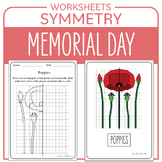24 results
Algebra 2 unit plans for staff

MCR3U, Fonctions, 11e année : Cours au complet (Course Pack)
------------------------------------------------------------------------------------------------------------------- ** FRENCH-LANGUAGE RESOURCE **English description provided at the bottom. Please scroll down.-------------------------------------------------------------------------------------------------------------------Fonctions 11e année, MCR3U, Cours au complet! Leçons, tests formatifs, revue pour l'examen finalTout dans un livre facile à imprimer et utiliser:Neuf unités, chacune avec un ho
Subjects:
Grades:
10th - 12th, Adult Education, Staff
Types:
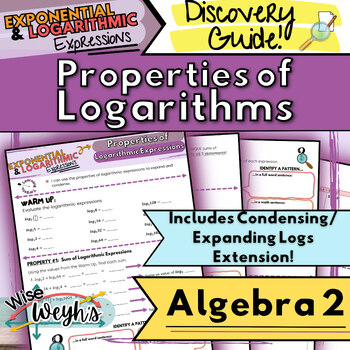
Properties of Logs Discovery Guide | Condensing and Expanding Logs Extension
Guide students to the discovery of the appropriate properties to expand and condense logarithmic expressions with this Properties of Logarithmic Expressions Discovery Guide + Condensing and Expanding Logs Extension! This lesson includes a Warm Up that asks your students to evaluate logarithmic expressions with the base of 2, and then prompts them to experiment with the outcomes of adding, subtracting, and multiplying these logarithmic expressions by a constant. This experimentation leads studen
Subjects:
Grades:
11th - 12th, Staff
Types:
CCSS:
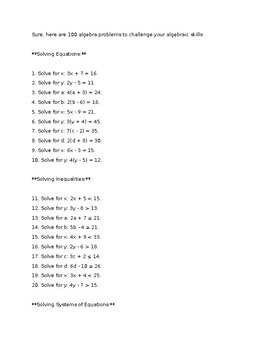
Transform Your Classroom with Engaging Algebra Practice: 100 Problems Worksheet
"Transform Your Classroom with Engaging Algebra Practice: 100 Problems Worksheet"Description:Are you searching for the perfect resource to supercharge your algebra lessons and captivate your students' mathematical minds? Look no further! Our "100 Problems Algebra Worksheet" is the ultimate solution to elevate your classroom experience, engage your students, and drive algebraic mastery. **Unlock the Power of Algebra:** Our meticulously crafted worksheet offers 100 diverse algebra problems designe
Grades:
PreK - 12th, Higher Education, Adult Education, Staff
Types:
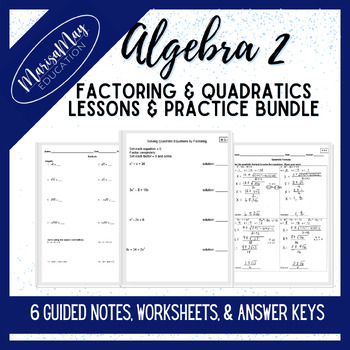
Algebra - Factoring & Quadratics Notes & Worksheets Bundle
Are your Algebra students starting their Factoring and Quadratics Unit and you're looking for an easy ready to go lesson plan bundle to be able to just hit print & teach? If so, these ready to teach lessons will provide you with just what you need!What topics it covers:Multiplying PolynomialsFactoring - Day 1Factoring - Day 2Solving Quadratic Equations by FactoringRadicalsSolving Quadratic Equations using the Quadratic FormulaWhat is included in this resource?⭐ Guided Student Notes for each
Subjects:
Grades:
9th - 12th, Higher Education, Adult Education, Staff
Also included in: Algebra - Factoring & Quadratics Complete Unit Bundle
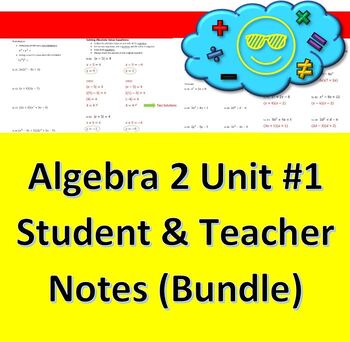
(BUNDLE) Algebra 2 Unit #1 Equations & Inequalities - Student & Teacher
Algebra 2 Unit #1 - Student Notes & Teacher Notes and Solutions (Bundled)Solving Equations and InequalitiesSolving Compound InequalitiesPolynomial OperationsSolving Absolute Value Equations and InequalitiesFactoringSolving Quadratic Equations By FactoringSolving Quadratic InequalitiesUnit #1 Review
Subjects:
Grades:
9th - 12th, Higher Education, Adult Education, Staff
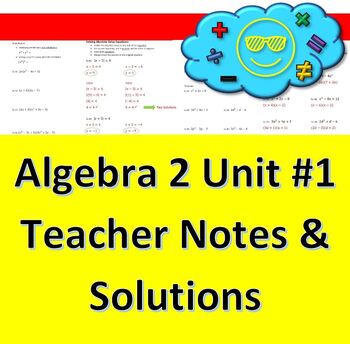
Algebra 2 Unit #1 Equations & Inequalities - Teacher Solutions
Algebra 2 Unit #1 - Teacher Notes and SolutionsSolving Equations and InequalitiesSolving Compound InequalitiesPolynomial OperationsSolving Absolute Value Equations and InequalitiesFactoringSolving Quadratic Equations By FactoringSolving Quadratic InequalitiesUnit #1 Review
Subjects:
Grades:
9th - 12th, Higher Education, Adult Education, Staff
Also included in: (BUNDLE) Algebra 2 Unit #1 Equations & Inequalities - Student & Teacher

RULES of LOGARITHMS & SOLVING LOGARITHMIC EQUATIONS
Logarithms helps us represent large numbers in very compact form. It can also be used to tell us how many of one number we must multiply to get another number.
The exponential function y=a^x is one of the most important functions in mathematics, physics, and engineering. Applications relating to radioactive decay, bacterial growth, population growth, continuous interest all involve exponential functions. We know that logarithmic and exponential functions are inverses. This means one can chan
Subjects:
Grades:
9th - 12th, Higher Education, Adult Education, Staff
Types:

Exponential & Logarithmic Functions Bundle (Algebra II) Common Core Aligned
The problems and activities within this document are designed to assist students in achieving the following standards: HSF.LE.A, HSF.IF.C.7.E, HSF.IF.C.8, HSN.Q, as well as the standards for mathematics practice and the literacy standards. They are also designed to help the teacher assess the students’ abilities when it comes to working with the ideas within the standards.
This folder contains the following:
- quick review problems of exponent properties
- guided notes, practice problems, and
Subjects:
Grades:
7th - 12th, Higher Education, Adult Education, Staff
Types:
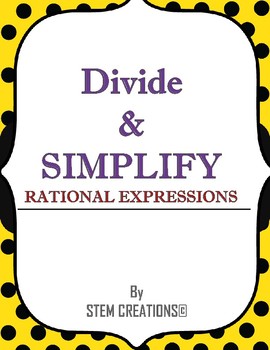
HOW TO DIVIDE AND SIMPLIFY TWO RATIONAL EXPRESSIONS
OUTLINE
In order to divide and simplify two rational expressions:
1. Multiply the first rational expression by the reciprocal of the second rational expression.
2. Factor each numerator polynomial and multiply out the factors
3. Factor each denominator polynomial expression and multiply out the factors
4. Apply the fundamental principle of fractions by dividing the common factor or factors.
5. The simplest form will be the quotient of the product of remaining expressions
Subjects:
Grades:
8th - 12th, Higher Education, Adult Education, Staff
Types:
Also included in: ALGEBRA I & II BUNDLED NOTES FOR ONLINE TEACHERS

ALGEBRA: LONG DIVISION OF POLYNOMIALS
At the end of this lessons, the students should be able to mimic the steps involved in the long division of polynomials.
------------------------------------
STEPS required for Dividing by a Polynomial Containing More Than One Term during long division:
Step 1: Express the polynomial being divided out with terms of descending order of powers. If any terms are missing, use a zero to fill in the missing term.
Step 2: Divide the term with the highest power inside the division symbol by the term
Subjects:
Grades:
10th - 12th, Higher Education, Staff
Types:
Also included in: ALGEBRA I & II BUNDLED NOTES FOR ONLINE TEACHERS

HOW TO SOLVE RATIONAL EQUATIONS
At the end of this lesson, the students must be able to learn how to solve rational equations.
The steps involved in solving a rational equation are:
1. Find the least common denominator of the equation.
2. Multiply each expression in the equation by the least common denominator.
3. Simplify each expression completely.
4.Solve the simplified equation
5. Check the solution(s) found to make sure there isn't an extraneous solution.
Subjects:
Grades:
9th - 12th, Higher Education, Adult Education, Staff
Types:
Also included in: ALGEBRA I & II BUNDLED NOTES FOR ONLINE TEACHERS

ALGEBRA 2: THE DISCRIMINANT IN QUADRATIC EQUATIONS
A quadratic equations is an equation of the form ax^2 + bx + c=0.
There are several other ways of solving a quadratic equation. In this document, we discuss how one can use the Quadratic formula to determine the type of solutions in a quadratic equation. The discriminant (D) is given by: D= b^2 - 4ac
The Discriminant tells us whether the equation will have one real solution or two real solutions or two imaginary solutions in a quadratic equation.
If D=0 , then the quadratic equation has only
Subjects:
Grades:
9th - 12th, Higher Education, Adult Education, Staff
Types:
Also included in: ALGEBRA I & II BUNDLED NOTES FOR ONLINE TEACHERS

THE AREAS OF SQUARES & RECTANGLES
In this e-document, I will examine basic area concepts that relate to the process of finding the area of a square and rectangle. Manipulation facts are also discussed. Using this document, instructors can have students work in groups and have them find areas of irregular figures that can be portioned into squares and rectangles. The formulas for for finding the finding the areas of squares and rectangles are also given.
Subjects:
Grades:
5th - 12th, Adult Education, Staff
Types:
Also included in: ALGEBRA I & II BUNDLED NOTES FOR ONLINE TEACHERS

ALGEBRA - THE QUADRATIC FORMULA and THE DISCRIMINANT
OBJECTIVES
1. The student should be able to express quadratic equations in standard form:
ax^2 + bx+c =0 and be able to extract the numbers, a, b and c.
2. The student should be able to find the discriminant, D= b^2 - 4ac in the quadratic formula and be able to identify the three types of solutions that one can get when solving a quadratic equation.
3. The student should be able to solve quadratic equations by using the quadratic formula.
Subjects:
Grades:
7th - 12th, Higher Education, Adult Education, Staff
Types:
Also included in: ALGEBRA I & II BUNDLED NOTES FOR ONLINE TEACHERS
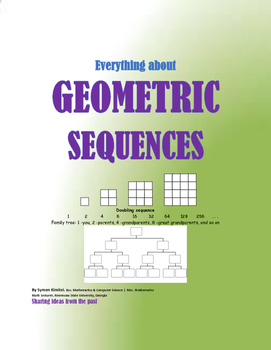
THE GEOMETRIC Series
A GEOMETRIC Series
Whenever a series of numbers follow a pattern of multiplying a term by a constant each term to arrive at the next term, we regard such a sequence as a geometric sequence. The constant multiplied each time is the same. This fixed constant that is being multiplied to arrive at the next term is called the common ratio, r, referring to the fact that the ratio (fraction) of the second term to the first term yields this constant. To find the common ratio, divide the second term b
Subjects:
Grades:
9th - 12th, Higher Education, Adult Education, Staff
Types:
Also included in: ALGEBRA I & II BUNDLED NOTES FOR ONLINE TEACHERS
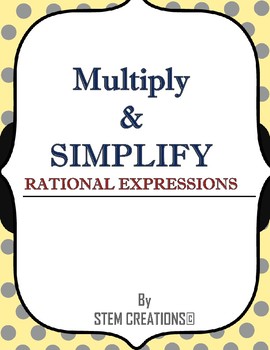
HOW TO MULTIPLY AND SIMPLY TWO OR MORE RATIONAL EXPRESSIONS
OUTLINE
In order to multiply and simplify two rational expressions:
1. Factor each numerator polynomial and multiply out the factors
2. Factor each denominator polynomial expression and multiply out the factors
3. Apply the fundamental principle of fractions by dividing the common factor or factors.
4. The simplest form will be the quotient of the product of remaining
Subjects:
Grades:
9th - 12th, Higher Education, Adult Education, Staff
Types:
Also included in: ALGEBRA I & II BUNDLED NOTES FOR ONLINE TEACHERS
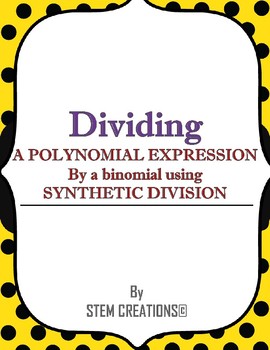
SYNTHETIC DIVISION AND POLYNOMIALS
OUTLINE
1. Express the polynomial in standard form
2. Write out the coefficients of the polynomial, ensuring that a zero is placed
appropriately as coefficients for missing degrees of the polynomial
3. Solve the binomial divisor equal to zero
4. Apply the multiply and add Patterns
5. The remainder from the division is the result from the last column of the add
patterns.
6. If this remainder is a zero, then the divisor is a factor of the polynomial
Subjects:
Grades:
9th - 12th, Higher Education, Adult Education, Staff
Types:
Also included in: ALGEBRA I & II BUNDLED NOTES FOR ONLINE TEACHERS
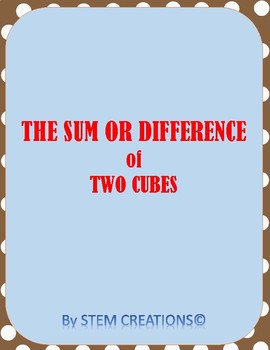
ALGEBRA: THE SUM OR DIFFERENCE OF TWO CUBES
At the end of the lesson, the student should be able to recognize polynomials that are a sum or difference of cubes and be able to factorize them.
A polynomial in the form
A^ 3 + B^3 is called a sum of cubes. When factored,
A^ 3 + B^3 = (A+B)(A^2 - AB + B^2)
A polynomial in the form
B^3 – B^ 3 is called a difference of cubes. When factored,
A^ 3 - B^3 = (A-B)(A^2 + AB + B^2)
Subjects:
Grades:
10th - 12th, Higher Education, Adult Education, Staff
Types:
Also included in: ALGEBRA I & II BUNDLED NOTES FOR ONLINE TEACHERS
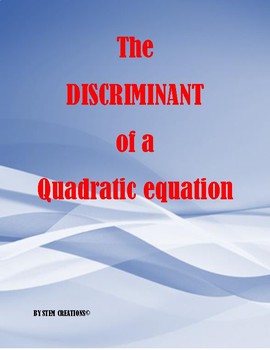
FINDING THE DISCRIMINANT OF A QUADRATIC EQUATION
A quadratic equations is an equation of the form ax^2 + bx + c=0.
There are several other ways of solving a quadratic equation. In this document, we discuss how one can use the Quadratic formula to determine the type of solutions in a quadratic equation. The discriminant (D) is given by: D= b^2 - 4ac
The Discriminant tells us whether the equation will have one real solution or two real solutions or two imaginary solutions in a quadratic equation.
If D=0 , then the quadratic equation has only
Subjects:
Grades:
9th - 12th, Higher Education, Adult Education, Staff
Types:
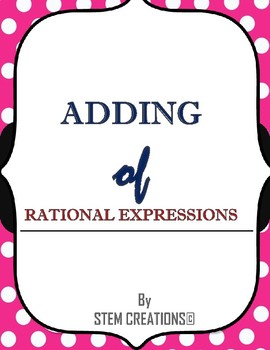
HOW TO ADD and SIMPLIFY RATIONAL EXPRESSIONS
OUTLINE
1. Determine if the given rational expressions have the same Least common denominators.
2. If not, find their Least common denominator.
3. Rewrite the given rational expressions as equivalent rational expressions with the same common denominator.
4. Apply the basic definition of adding rational numbers with a common denominator.
5. Simplify the final result by canceling out common factors in the numerator and denominator of the final result to attain the simplest form.
Subjects:
Grades:
9th - 12th, Higher Education, Adult Education, Staff
Also included in: ALGEBRA I & II BUNDLED NOTES FOR ONLINE TEACHERS

SOLVING A SYSTEM OF LINEAR EQUATIONS BY SUBSTITUTION
SOLVING A SYSTEM OF LINEAR EQUATIONS BY SUBSTITUTION
The graphing method for solving a system of linear equations only works well when the ordered pair solution are only integers. Therefore, we need an algebraic method for solving systems of equations. There are two algebraic methods that we can use to solve a system of equations. These are:
I. The Substitution Method
II. The Elimination Method.
This e-book discusses the Substitution Method
The steps involved when solving a system of linear
Subjects:
Grades:
9th - 12th, Higher Education, Adult Education, Staff
Types:
Also included in: ALGEBRA I & II BUNDLED NOTES FOR ONLINE TEACHERS

ALGEBRA - THE DIFFERENCE OF TWO SQUARES RULE
At the end of this lesson,
1. The student should be able to recognize that a given expression is the difference between two squares
2. The student should be able to apply the difference of two squares rule to factorize the expression
Subjects:
Grades:
7th - 12th, Higher Education, Adult Education, Staff
Types:
Also included in: ALGEBRA I & II BUNDLED NOTES FOR ONLINE TEACHERS
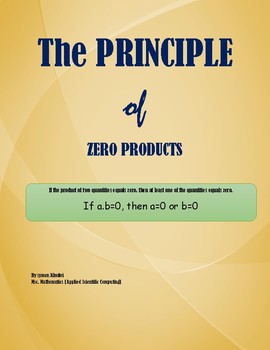
ALGEBRA: THE ZERO PRODUCTS PROPERTY FOR SOLVING EQUATIONS
THE ZERO PRODUCTS PROPERTY:
If the product of two quantities equals zero, then at least one of the quantities equals zero.
In other words, If a.b=0, then a=0 or b=0
We have given several examples in this document to show how this principle(rule or property) is used to solve equations.
Subjects:
Grades:
7th - 12th, Higher Education, Adult Education, Staff
Types:
Also included in: ALGEBRA I & II BUNDLED NOTES FOR ONLINE TEACHERS

EXPONENTIAL DECAY WITH EXAMPLES
Exponential growth or decay can be modeled using an exponential function of the form:
y = P ( a) ^x
P = initial value of y
x = time or any value for x
a = multiplication factor
If then the function y is an exponential decay where a = 1 - r
and r is the decay rate as a decimal number.
This document discusses applied problems that relate to exponential growth or decay. The ideas have been laid out so that they are easy to follow. Questions and answers are given. Step by step solutions are a
Subjects:
Grades:
9th - 12th, Higher Education, Adult Education, Staff
Types:
Also included in: ALGEBRA I & II BUNDLED NOTES FOR ONLINE TEACHERS
Showing 1-24 of 24 results

